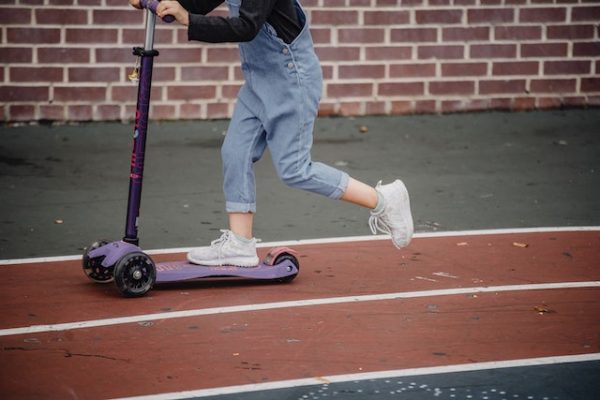We’ve all seen children whizzing around on scooters, their faces lit up with joy. But did you know that scootering is more than just a fun activity? It’s actually a fantastic tool for developing motor skills. The act of scootering involves a host of gross and fine motor movements, helping children build strength, balance, and coordination. Not only that, but it also offers cognitive benefits, like improving focus and decision-making abilities.
As parents, caregivers, or educators, we must ensure that this activity is carried out safely while still keeping it enjoyable for the child. In this article, we’ll guide you through the benefits of scootering, teach you how to encourage your child to scooter and help you choose the right scooter. We’ll also show you how to incorporate scootering into daily routines and even introduce some advanced tricks for continued development.

We at FamilyHype are confident that with the help of this article, you’ll be able to make scootering a fun and rewarding learning experience for your child. Let’s dive in and discover how a simple scooter can be a fun learning tool. Don’t forget to share your feedback with us in the comment section below!
And if you’re looking for other activities and tools to help your child with their development, consider checking out our collection of toys, books, and activities related to gross and fine motor skills development, including balance and motor planning, as well as coordination and strength.
Key Points And Takeaways
- Scootering is a fantastic tool for developing motor skills in children.
- Scootering offers cognitive benefits like improving focus and decision-making abilities.
- Safety measures, such as regular maintenance and wearing protective gear, are important while scootering.
- Scootering promotes independence and the ability to make decisions.
Understanding Your Child’s Development
Let’s unravel the concept of motor development, a fascinating process that’s as crucial as it is captivating! It’s an integral part of a child’s growth that allows them to interact and navigate their environment confidently and safely.
There are two main types of motor skills: gross, which involves larger movements, and fine, which involves precise, smaller movements. Both types of movement are important to develop. Motor skills myths often perpetuate misconceptions, like the idea that all children progress at the same rate. In reality, development stages vary greatly among children. It’s important for us to understand this diversity and offer support tailored to each child’s unique pace.
Now, with a clearer understanding of motor development, we’re ready to dive into the exciting world of scooters, an excellent tool to enhance these areas while having tons of fun!
The Basics Of Riding A Children’s Scooter
Let’s dive into the exciting world of scootering and, more specifically, the different types of kids’ scooters available on the market. We’re also going to chat about the essential safety measures while scootering because as much as we love fun, we’re even more passionate about keeping our little ones safe. Scootering can be a thrilling activity, but ensuring it’s done safely is our top priority.
The Different Types Of Kids’ Scooter Models Available On The Market
You’ll be amazed at the variety of kids’ scooters available, each designed to enhance motor development while delivering a fun, engaging outdoor activity.
There are several types to consider:
- Three-Wheel Scooters: These are perfect for beginners, offering stability and balance while learning the ropes.
- Two-Wheel Scooters: Ideal for older kids, they require more balance and coordination, promoting skill development.
- Electric Scooters: These offer speed control, which is valuable for teaching kids about safety and responsibility.
- Stunt Scooters: These are designed for tricks and jumps, fostering creativity and agility.
Remember, maintenance is essential to ensure long-lasting use. Moreover, scooter customization adds a personal touch, making scootering more enjoyable for your child. Having discussed these types, let’s now delve into the crucial aspect of safety measures.
Important Safety Measures To Keep Your Child Safe While Riding
Navigating the pavement on your child’s new set of wheels can be a thrilling adventure, but it’s absolutely paramount to ensure they’re equipped with the right safety gear. As caregivers, we understand the importance of safety first. This is why we emphasize regular scooter maintenance and wearing protective gear.
Let’s ensure the scooter is in tip-top shape, with no loose parts, and the brakes functioning correctly. Protective gear like helmets, knee, and elbow pads are non-negotiables—they’re crucial for cushioning any accidental falls. We also encourage practicing safe riding habits, like riding at a safe speed and paying attention to their surroundings.
As we continue to prioritize safety, let’s remember it’s all part of the journey to help your kids develop through scootering. Next, we’ll explore this correlation in detail.

Gross Motor Development In Children
Scootering isn’t just a thrilling activity for kids, it’s also a fantastic way to enhance their gross motor skills! Regularly riding a scooter can help develop coordination, balance, and strength. It takes a lot of leg power to push off the ground and keep moving. Plus, steering and maintaining balance engage the core and upper body.
Scooter maintenance plays a pivotal role too. Cleaning, tightening screws, and checking the wheels for wear and tear can teach responsibility and initiative. Moreover, scooter races are an exciting way to encourage children to refine their skills and gain confidence. These races can be friendly competitions among peers, promoting teamwork and healthy rivalry.
Next, let’s delve into how scootering can also boost fine motor skills.
Fine Motor Development In Children
Having discussed the impact of scootering on gross motor skills, let’s now delve into how it can enhance fine motor skills. Scooter maintenance is more than just a responsibility; it’s a great avenue for little ones to develop their coordination. Tightening bolts, adjusting handlebars, or attaching accessories all require precision and hand-eye coordination. Concurrently, scootering etiquette is another valuable tool. Gesturing to fellow riders, maneuvering around an obstacle course, and using brakes effectively all hone these skills, too.
Not only does scootering build physical strength, but it also encourages attention to detail, patience, and respect for others. As we’ll explore next, these physical and social skills can have a profound impact on cognitive growth, setting the stage for a more in-depth conversation about the cognitive benefits of scootering.
The Many Cognitive Benefits Of Riding A Scooter
Beyond just physical prowess, it’s fascinating to observe how scootering can act as a catalyst for cognitive growth in children. The tasks of balancing, steering, and maneuvering all require a fair amount of mental acuity. In particular, navigation is also honed as children must decide when to turn, stop, or speed up. This kind of decision-making stimulates their cognitive development and problem-solving abilities.
What’s more, scooter maintenance is an excellent opportunity for kids to understand the mechanics involved, thereby fostering their technical knowledge. It’s a hands-on learning experience that can be both engaging and rewarding. As we transition into the next section, let’s explore how these cognitive benefits can contribute to a child’s emotional well-being through scootering.
The Many Emotional Benefits Of Riding A Scooter
Just as scootering helps develop cognitive abilities, it also has significant emotional benefits. It’s a fantastic way to boost our kids’ confidence, letting them feel accomplished and capable as they master new abilities. Plus, scootering encourages a sense of independence, teaching our little ones to navigate and explore their surroundings safely and responsibly.
It Can Help Build Confidence And Self-Esteem In Children
When you’re mastering the art of balancing and maneuvering on a scooter, you’re also unknowingly bolstering your self-confidence. You see, scootering isn’t just about fun; it’s about self-esteem enhancement too. As you start to get the hang of it, you begin to overcome fears you may have had about falling or failing. It’s a lesson in courage, perseverance, and resilience, all nicely wrapped up in an activity that brings joy and excitement.
It doesn’t stop there, though. Each successful ride fuels your confidence, pushing you to take on more challenging routes or even try new tricks. It’s an empowering experience that leaves you feeling capable and accomplished. That’s how scootering contributes to building confidence, setting the stage for self-reliance and autonomy in the next chapter of your journey.
It Can Help Develop Autonomy And Independence In Children
In the grand scheme of things, there’s nothing quite like the taste of independence you’ll find zipping around on two wheels, exploring your surroundings, and deciding your own path. The thrill of scooter riding can significantly boost personal autonomy and develop decision-making skills in children.
- Freedom to Explore: Scootering allows children to venture out, explore their environment, make decisions, and learn from their experiences.
- Self-Reliance: Managing a scooter independently teaches children to rely on their abilities, nurturing confidence in their skills.
- Decision Making: The need to navigate and choose paths helps children develop quick decision-making skills, a valuable life skill.
These benefits of scootering are not just exciting but also crucial in a child’s development journey. Now, let’s delve into some handy techniques to nudge your little ones into the wonderful world of scootering.
Some Tips To Encourage And Motivate Your Child
Encouraging your child to ride isn’t just about fun. It’s also a great tool to develop their abilities and boost their confidence. Start with the basics, like demonstrating how to step on and off the scooter safely. Stress the importance of wearing a helmet every time they ride to ensure their safety.
Make Your Child Feel Included, Even In The Small Things
Make maintenance a shared task. Teach them to check the wheels and brakes before each ride, instilling a sense of responsibility and care. Praise their efforts and progress, no matter how small. This will build their confidence and make them eager to learn more. Remember, the goal is to make it a joyful experience rather than a chore or a lesson. As we move forward, let’s explore how we can seamlessly weave scooter time into their everyday activities for extra practice.

Making It A Part Of Your Child’s Daily Routine
Isn’t it amazing how seamlessly we can blend our child’s passion for scootering into their daily routines, making it less of a task and more of an adventurous journey they look forward to every day? It’s not just about hopping on a scooter and whizzing down the road, but a fun way to learn important life lessons.
Teach Your Child The Basics Of Equipment Care And Maintenance
Teaching them to take care of their scooter helps instill a sense of responsibility. They learn to:
- Clean it regularly
- Check for any damages
- Fix minor issues
Help Your Child Identify And Plan The Best Paths And Riding Routes
This encourages exploration and enhances their navigation skills. They learn to:
- Identify safe paths
- Plan their journey
- Adjust their route when necessary
Incorporating scootering into daily routines can be a stepping-stone toward choosing the right model for your child’s needs.
Choosing The Right Model For Your Child’s Age And Size
Finding the perfect set of wheels for your little one might seem like searching for a needle in a haystack, but with the right approach, it’s a journey of discovery that can be as exciting as the first ride. The key to choosing the right one lies in considering your child’s age, size, and experience level. It’s not just about the color or design; maintenance and customization also play crucial roles. Maintaining the scooter ensures your child’s safety, while customization allows it to grow with your child, keeping them engaged and challenged.
When chosen wisely, a scooter can be a perfect tool for development. As they progress and become more confident, they’ll be ready to explore more advanced tricks for continued development.
Learning Advanced Tricks For Continued Development
After we’ve found the perfect model for our little ones, it’s time to dive deeper. Let’s now shift our focus to Advanced Scootering Tricks for Continued Development.
Scootering is not just about riding from point A to point B; it’s an opportunity for our children to develop more advanced abilities and have fun while doing it. Of course, safety is paramount, so we ensure they’re always wearing the right gear. As they become more comfortable, they can learn innovative tricks, further enhancing their motor activity, coordination, and balance. Additionally, teaching them scooter maintenance helps instill responsibility and attention to detail.
Remember, it’s not just about the ride. It’s about the journey and the lessons they acquire along the way.
Conclusion And Final Thoughts
Scootering with your family is an effective and fun way to help your child develop their motor skills. By using FamilyHype’s tips and finding the right scooter for your child, you can help your kids grow, learn, and stay safe. Whether it’s about tricks, speed, strength, coordination, or cognitive learning, these activities offer a variety of benefits and are a great way to engage with your child in a meaningful way. Let’s get them scootering! Don’t forget to share your feedback with us and other families. We’d love to hear your stories and experiences.
At FamilyHype, we strive to make sure parents have access to the best resources for scootering and recreational activities. Whether it’s finding the perfect scooter, getting the right safety gear, or learning helpful tips from other parents, we want to help make the scootering experience the best it can be.
Frequently Asked Questions (FAQs):
Is Riding A Children’s Scooter Considered A Motor Skill?
Riding a scooter can help your child develop both their fine and gross motor development, as well as their cognitive abilities.
Can Riding One Really Help Boost Your Child’s Development?
They are not only good for your child’s physical development, but they also help improve their motor planning, cognitive abilities, and decision-making. When your child rides a scooter, they learn how to move their limbs independently, which improves their motor development. This, in turn, increases children’s confidence and leads to personality development as well. It also encourages outdoor play.
What Is An Example Of A Movement Skill?
Gross motor skill development includes movements like running, sitting, jumping, climbing, swimming, standing, and crawling. Fine motor development involves using the muscles in our hands and wrists in coordination with our other senses. Examples are holding a pencil to write, playing with building blocks, cutting paper, and more.
What Does Motor Development Mean Exactly?
Motor development refers to your child’s ability to use their body and perform physical tasks. It is usually divided into two main types: gross motor skill and fine motor skill.
What Are Some Of The Top Benefits Of Riding A Scooter In PE?
They aren’t just a fun physical activity for your kids. They also help increase your child’s strength, focus, and coordination. When done in a group setting, they can also help foster teamwork among peers.
Why Do People Consider It A Better Activity Than Riding A Bike?
This comes down to preference, but many customers choose scooters over bikes because they believe they’re better for a child’s posture in the long run. They are also easier to store if you live in a small space.
Why Is It Important To Encourage Your Child To Ride One?
It is a fun way to get around, and it has so many physical and mental benefits for developing children.
Is It A Good Activity To Let Young Children Try?
Yes. It can help increase muscle strength, core strength, and body awareness.
Can Children With Special Needs Safely Use Them As Well?
Instead of traditional scooters, scooter boards are the ideal physical therapy tool for children on the autism spectrum and those with sensory and vestibular challenges. Scooter board activities can be done in a kneeling, sitting, or prone position. Some fun vestibular activities include body bowling (your child uses their body to scoot and knock down bowling pins) and bean bag sorting (your child scoots to the other end of a room to sort colored bean bags).
How Do I Pick Out A Good Scooter Board Model?
There are many scooter board models you can choose from if your child has vestibular difficulties, motor delays, or sensory issues, but make sure you pick one made of high-quality materials. Many scooter boards have plastic wheels, which can disintegrate quite quickly. Only let your child exercise with scooter boards at home under adult supervision.
DISCLAIMER (IMPORTANT): This information (including all text, images, audio, or other formats on FamilyHype.com) is not intended to be a substitute for informed professional advice, diagnosis, endorsement or treatment. You should not take any action or avoid taking action without consulting a qualified professional. Always seek the advice of your physician or other qualified health provider with any questions about medical conditions. Do not disregard professional medical advice or delay seeking advice or treatment because of something you have read here a FamilyHype.com.